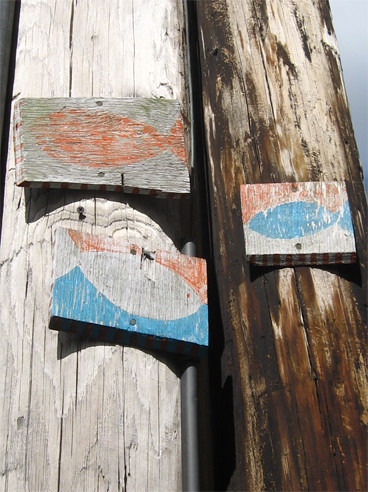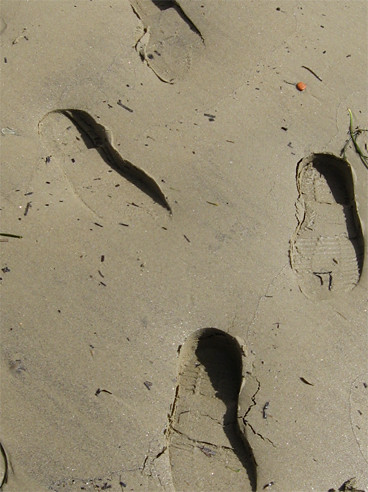A couple of weeks ago, I went up to Gloucester to teach a mime workshop for the local high school's drama club. They were rehearsing Jonathan Rand's play Check, Please. I was unfamiliar with the play but have since discovered that it is one of the most popular contemporary plays performed by high school theatre troupes in the United States. The play included mime-character in one of the scenes who engages in a number of the cliché moves often associated with mime, such as "being trapped in an invisible box" and "pulling on a rope." However, the company, which is very much guided by the students' interests, also wanted some grounding in basic mime technique for the sake of developing some choreographed stage business.
Arriving at the Gloucester train station at about 11:20, I did what I always do when my artistic career takes me to another town, which is to play tourist. I had last been to Gloucester the summer before to perform at the now defunct Fishtown Artspace and so knew my way around.
Artifacts of a counter culture: Signs on telephone poles marking outside the original location of the now defunct Fishtown Artspace.
Ever a bibliophile, I took advantage of the sale on used books at Mystery Train Records, and came out with perhaps as many theatre books as I wanted to lug around that day at a cost that I would normally expect to pay for a single book at a used store in Boston, Cambridge or Somerville. A walk on the beach was particularly interesting when I noticed that due to the low tide, the wet sand would sink two or three inches under my boot-steps.
After my lunch, I strolled maybe a mile-and-a-half and arrived at the school shortly before the dismissal bell and squared away the business issues with the drama teacher before being led to the auditorium where the drama club was beginning to gather. I took off my shoes, introduced myself, and briefly explained my view of mime's relationship to everyday body language as poetry's relationship to everyday verbal language-- reciting Shakespeare's 28th sonnet as an example. I then invited the student actors onto the proscenium stage.
The student techies and production staff alternated between attending to their own business and observing as I introduced the actors to the corporeal mime scale, in all three dimensions (lateral, depth, and rotation.) Mime is a difficult form to learn, and even a two-hour workshop is only sufficient to give the most skeletal of introductions, but the students were enthusiastic and willing to learn. They also had the advantage of being a bit older than my students at Open Air Circus, and so have more developed nervous systems and were better able to imitate my isolation work, as well as articulate their interpretations of the meaning of some of the isolations and sequences (the way a lateral translation of the head might represent listening, while a forward translation of the head is more representative of looking.)
After our isolation exercises, I was ready to teach them their first illusion: "the wall." The methodology I have developed is to have the students place their hands on a genuine wall, so that they can experience the flatness and verticality of the wall's plane, and then experience each isolation (including relevés and pliés) of the body with their hands fixed on the wall, asking them to make observations about the focus of their eyes and the compensations they need to make in order to keep their hands fixed to the wall. I also asked them to observe how their hand automatically relaxes when pulled away from the wall. I noted that as with Aristotle's note that the "soul (psuche) is analogous to the hand; for as the hand is a tool of tools, so thought is the form of forms" (On The Soul, III 8 432a1) the hand in it's ability to grasp forms" that in mime theatre, the hand is analogous to the mind, in that it takes the form of the character's thoughts. I then had them experience taking steps along the wall so they could feel just how far they could go before needing to release their grasp of the wall. After several minutes of these experiments, meant to demonstrate that a mime's craft relies heavily on naturalistic observation, I invited them back to the stage, both to demonstrate that with this new found knowledge of walls and an ability to move the whole body in an articulate matter, one sells the reality of the imaginary wall far more than one would with a simple hand gesture, and gave them several minutes to experiment on their own, as I walked amongst them making minor corrections.
Being inquisitive students, they asked me questions in between exercises:
Q: What is the relationship between mime and European clown traditions?
A: In the European context, mime and clown are close cousins, with a common ancestor in commedia dell'arte.
Q: Is there a rule that mimes have to perform silently?
A: No. Many perform silently in observance of mime's independent standing as an art form much as painting and sculpture are independent of one another, but there is no reason why one cannot speak and mime simultaneously. I performed some of my first mime pieces with poetic recitation.
Q: Do mimes always perform with white makeup?
A: No. If a mime chooses to wear makeup, it can be any color, or alternately, the mime can perform without makeup, or with masks. All such things are acceptable.
All this allowed for digressions on the history of mime, allowing me to discuss Charlie Chaplin, Étienne Decroux, Jean Louis-Barrault and Marcel Marceau.
Our next set of exercises were in rope pulling (both horizontally and vertically) and a tug 'o war exercise (a favorite with younger kids, who seem to find walls too abstract) to emphasize ensemble work, as well as to demonstrate the principles of oppositional and sequential movement. After a brief break (due to the techies noting that I had kept the actors working for an hour and a half straight through) explored the extremes of rhythmic dynamics: shock, fondue, and immobility and spent the last few minutes creating tableaux with some of the skills we covered over the previous two hours.
Monday, October 22, 2007
Mime Workshop in Gloucester
Posted by
Ian Thal
at
7:01 PM
![]()
![]()
Labels: Aristotle, corporeal mime, Étienne Decroux, Gloucester Massachusetts, Jonathan Rand, Marcel Marceau, mime, Shakespeare, teaching, theatre
Subscribe to:
Post Comments (Atom)



No comments:
Post a Comment